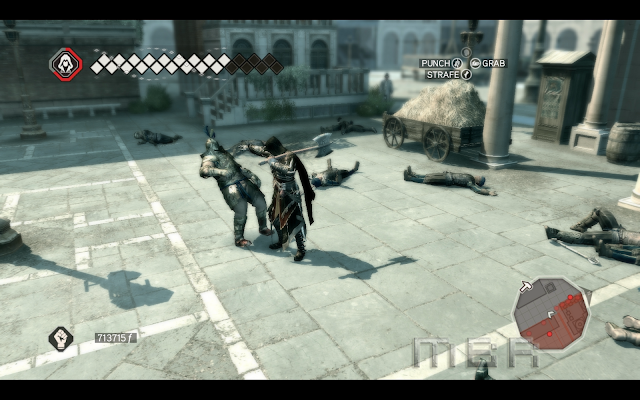This time around, the game is set in renaissance Italy, which
already makes it a much more colorful and visually appealing setting than the
drab war torn holy land of the previous game. Your new assassin is Ezio Auditore
da Firenze, who hungers for vengeance after his father and brothers where
killed as part of a cover-up by a network of many powerful men, the web of
which you spend much of the game unraveling. You learn from surviving family
that you come from a long line of assassins, and armed with this knowledge,
your father's hidden blade, and the help of various notable characters and
willing factions, you set out to uncover
the identity, and foil the plans, of the man known only as the Spaniard.
 |
| Hmm, The Spaniard. There's got to be a Princess Bride reference in there. |
There are new weapons, as well as new assassination options
that make the game feel much more natural. For example, you can now get a
pistol integrated into one of your hidden blades. I say one, because you unlock
a second blade early in the game, which opens up a whole 'nother world of cool
ways to kill people. Other weapons, like a poison blade, provide you with new
approaches to kill enemies without being detected. Those new assassination
options I mentioned really make you realize how much was missing in the
previous game, and you'll wonder how you made it without the ability to stealth
kill someone from inside a hay cart or while hanging on a ledge below someone.
However, while the assassin's tools of the trade have
evolved, so have the types of enemies you encounter. You can no longer just sit in a corner and
counterattack your way to victory, as more often than not you'll encounter
larger enemies that wield maces or pole arms, which can only be disarmed. Other
times you'll have to deal with light enemies, who make fleeing more difficult
as they are pretty much equally light of foot. At some points you'll have to
chase down an enemy messenger or a pickpocket, for a little bonus. All of these
serve to liven up the combat from what the original had to offer.
 |
| Speaking of being cliche - the bigger they are... |
That currency can be used in other ways to help you on your
mission as well. Scattering some on the ground serves as a great distraction to
guards and citizens alike. Or you could hire one of three groups - courtesans,
mercenaries, and thieves - to do things for you like provide cover so you can
blend in, distract guards, or attack for you - whatever the situation calls
for.
 |
| Sorry kiddies, no GTA options here. |
I really am amazed at how they turned this series around.
Rather than the main game being nothing more than a checklist of activities
before killing one target, with a good story when you're not in the past,
they've practically ditched the out of animus portion and made the main game a
very open, very enjoyable experience. Now there are plenty of side missions, which
really serve no purpose beyond increasing your available finances, and those
kind of become a little more repetitive, but since they've been moved out of
the main story, that's perfectly fine.
The heart of the game, the story behind it, the interesting
period characters you interact with, such as Leonardo da Vinci, make this a
really solid game. There is plenty of extra stuff in there, if you feel like
taking time to collect art, build a city, or hunt down over 300 treasure
chests, but that's all just bonus. I picked this up for under $7 back during
the summer of 2011, but I could easily see myself paying $10-$15 for it now,
knowing how good it is, and realizing that I spent over 36 hours of my life on
this experience. Overall, a very solid, good game, that I give a 7 out of 10.
So, the final breakdown:
Score: 7/10
Suggested Price: $15
No comments:
Post a Comment